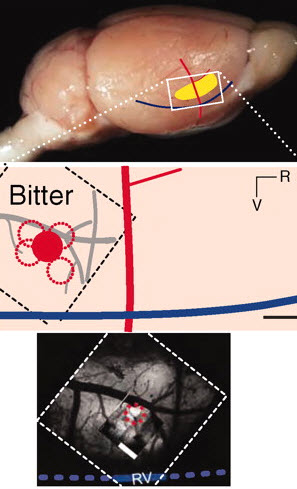New map shows where tastes are coded in the brain
September 6, 2011

Bitter hot spot in the mouse insular cortex (credit: Xiaoke Chen et al./Science)
Howard Hughes Medical Institute and NIH scientists have discovered that our four basic tastes — sweet, bitter, salty, and “umami,” or savory —- are processed by neurons arranged discretely in a “gustotopic map” in the brain.
In the past, researchers measured the electrical activity of small clusters of neurons to see which areas of a mouse’s brain were activated by different tastes. In those experiments, the areas responding to different tastes seemed to blend together, so scientists concluded that neurons appeared to process all tastes broadly.
Questioning that assumption, they tried a powerful new technique called two-photon calcium imaging to determine which neurons responded when an animal is exposed to different taste qualities.
How two-photon calcium imaging works
When a neuron is activated, it releases a wave of calcium throughout the cell. So the level of calcium can serve as a proxy for measuring activation of neurons. The researchers injected dye into the neurons of mice that made those cells light up with fluorescence every time calcium was released. Then, they looked at the brains of the mice under high-powered microscopes that allowed them to watch hundreds of nerve cells at a time deep within the brain of mice. When a cell was activated, the researchers saw it fluoresce. This allowed them to monitor the activity of large ensembles of cells, as opposed to previous methods, which tracked only a few cells at a time.
They observed that when a mouse is given something bitter to taste, or the receptors on its tongue that sense bitter are stimulated, many neurons in one small, specific area of the brain light up. When the mouse is given something salty, an area a few millimeters away is activated. Each taste corresponded to a different hotspot in the brain. None of the areas overlapped — in fact, there was space between all of them.
“The idea of maps in the brain is one that has been found in other senses,” says Nicholas J. P. Ryba of the National Institute of Dental and Craniofacial Research. “But in those cases the brain maps correspond to external maps.” Visual neurons are found in an arrangement that mimics the field of vision sensed by the eyes. However, taste offers no preexisting arrangement before reaching the brain; furthermore, the receptors for all tastes are found randomly throughout the tongue — thus the spatial organization of taste neurons into a topographic brain map is all the more surprising.
The researchers next want to uncover how taste combines with other sensory inputs like olfaction and texture, and the internal state — hunger and expectation, for example — to choreograph flavor, taste memories, and taste behaviors.
Ref.: Xiaoke Chen, et al., A Gustotopic Map of Taste Qualities in the Mammalian Brain, Science, September 2011 [DOI: 10.1126/science.1204076]